Camp Fife History
1853
Thomas Xavier Fife
Thomas Xavier Fife (Tom Fife) was born on 15th May, 1853, in Fifeshire, Scotland, United Kingdom, to his father, John M. Fife (34), and his mother, Margaret G Fyfe (33).
Tom Fife came to the United States of America on July 5th, 1866, at age 13 with his father, John. The pair worked their way across the country, in the coal mines of Pennsylvania, prospecting for gold in Wyoming, and for two years on the Salt Lake Temple, then under construction in Utah. In 1880, the census showed Tom Fife living in Almy, Wyoming, where he was reported to be 26 years old and working as a laborer.
1886

Fifes Settle in Goose Prairie
Tom Fife eventually relocated to Goose Prairie in 1886 with his father, John. Together, they homesteaded 146 acres. Friend Supreme Court Justice William O. Douglas and others said this name came from a lone snow goose that spent time there with the Fifes, who then named the area for the bird. By 1887, the first cabin was built.
Soon after, on November 9th, 1890, John Fife passed away and became the first person to be buried in the Goose Prairie graveyard.
Tom was also active in many local mining operations, including the Gold King, Emma, Blue Bell, Tip Top, and Gold Dust Placer quartz claims, as well as the Thomas Fife Mill site, according to the Yakima Herald. These claims were located in the Gold Hill or Summit district. In 1900, Fife transferred these claims to the Blue Bell Mining Co.
1912
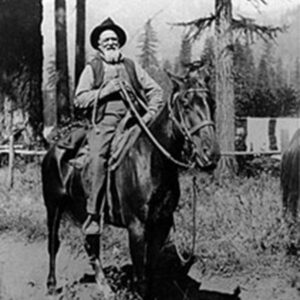
“Tom Fife, a Scottish immigrant who homesteaded Goose Prairie, is shown on horseback in a 1912 photo. He donated a portion of his homestead to the Boy Scouts of America for use as a camp.”
Yakima Herald | Photo courtesy Yakima Valley Museum
1915
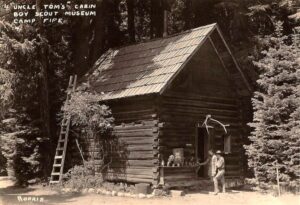
Tom’s Fife’s Second Cabin
‘Uncle Tom’s Cabin’ was built after his original cabin burned down, and on its completion, he lived in it until he passed away. The cabin has moved around the prairie and been owned by two other families, finding its final resting place next to the cemetery, where it remains today.
1922

Tom Fife Passed Away
On November 12th, 1922, Tom Fife passed away.
1923

Camp Fife is Born
The final will of Tom Fife was executed with the formal deed signed to the Yakima Council Boy Scouts of America on August 6th at 3.59pm, 1923. This marks the official start of the use of the property as ‘Camp Fife’.
It comprised of 10 acres (Lot 5) and an additional 1 acre to host the local Gooseprairie Cemetery; today, this is referred to as the Camp Fife Cemetery. The remaining 136 acres were divided into 51 lots. Over the years, many of these were added to the Camp Fife footprint, which makes the 62 acres that exist today.
1926
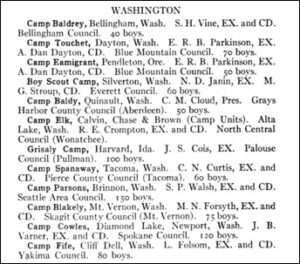
First Recorded Summer Camp
The National ‘Summer Camps 1926 – A Handbook for Summer Camps’, on page 124, shows that this year, 80 boys attended Camp Fife for their Summer Camp. Although it is believed that summer camps started immediately in 1924.
1935
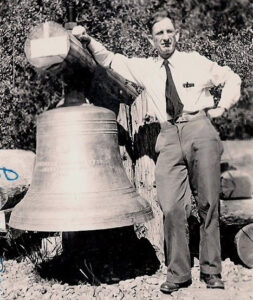
Camp Development and Camp Bell
At the same time, the kitchen and dining hall were being built, Walter S Gallant did the original hanging of the camp bell. The bell was critical to the whole of Gooseprairie, where it is still used today as a fire warning.
The bell is from McShane Bell Foundry, which cast it in 1889 in Baltimore, MD. This is America’s longest bell manufacturing business.
The bell’s original location was left of the current program lodge, where, among the trees, you can still see remnants of the rockery that housed the bell and a water fountain. It has, however, had multiple locations over the years.
1936

Original Dining Hall and Kitchen Opened
Construction of the first dining hall and kitchen began in 1935. Construction was completed in 1936, including a fireplace. Timber from the newly built roadway from the American River to Bumping Lake was offered and used for the construction.
Following this development, Camp Fife continued to grow. In 1937, winter camping was introduced with 150 scouts in attendance. The summer of 1937 had 267 scouts in attendance. The camp staff consisted of a camp director, an assistant camp director, a nature study director, a camp cook, five Eagle Scouts, and the scoutmasters who arrived with their troops.
1938
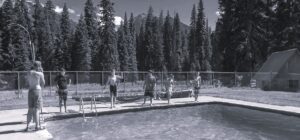
Pool is Opened
The original swimming pool was built and remains a popular attraction, with upgrades including heating added in 1955, a shower house in 1974, and new shower rooms in 2003.
1955
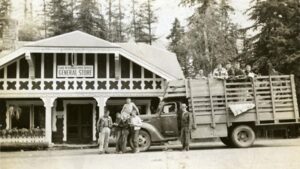
Curtiss Gilbert Opened
The Curtiss Gilbert building was completed in 1955. This was named after the infamous Scout leader from Yakima Troop 9, who, among a vast number of extraordinary troop hikes (including climbing to the top of every volcano in WA, OR, and CA and having a mountain named after him), completed a 39-day troop journey around America in a fruit truck!
1960

More Growth to the Camp Fife
Fife Pond or Fife Lake (depending on who you talk to) was built in Sept of 1960. It is fed by spring runoff, but didn’t hold water through the summer. In 1966, the lake was sealed with sand over plastic film. It held water for a while, but the plastic soon developed holes from elk and other wildlife walking through it, and the water seeped out again. Today, it collects water from spring snowmelt and is mainly used by Canadian Geese, but as summer approaches, the water seeps out and soon dries up again.
1960 was also the year a 50 kW diesel-driven generator was installed, bringing the luxury of power to Camp Fife.
1963
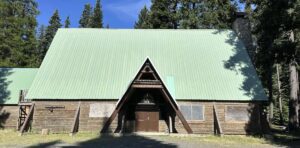
New Dining Hall and Kitchen
This year saw fundraising and the building of a new dining hall and kitchen, after it was reported that the old one had burned down. After the current kitchen and dining hall were built, it was used as a trading post. This building remains to this day, now the program lodge, offering an excellent location for training and indoor activities. The original fireplace remains as a link to the original building, and much of the original architecture is replicated.
1987
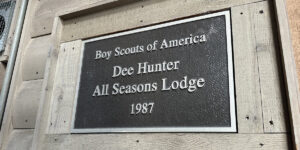
Dee Hunter All Seasons Lodge Opened
This building was added to provide year-round indoor accommodations and was immediately a hit with troops for use during winter.
2003
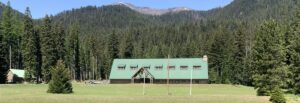
Multi Aspect Upgrade
A massive multi-year camp upgrade project that included a number of upgrades and additions over the coming years…
2003 – Upgraded male shower house next to the pool.
2004 – A new, additional dining hall was built and opened.
2006 – Rangers House finished construction.
2006 – New road creating a new gate, with the ‘red gate’ now being secondary.
2019
Covid and Scouting Changes
Camp Fife, like much of the world, was impacted by COVID-19. This was exacerbated by a number of Boy Scouts of America and Grand Columbia Council situations that led to an over 50% decline in their membership. Little did people know at the time, but this would be the last Summer Camp until today, six years later.
In 2021, Friends of Camp Fife began taking on a more leadership role at Camp Fife to maintain it and move it into the next chapter of its life, with an agreed direction to transfer management and possibly ownership.
In April 2023, the Grand Columbia Council merged with the Chief Seattle Council, and discussions were put on pause, with communications from Chief Seattle leadership made public about revitalizing the property.
2025
October 1st Closure
Unfortunately, this revitalization didn’t come to fruition, and as of October 1st, 2025, the council stopped accepting new reservations, effectively shuttering the property.
Currently, the Friends of Camp Fife are again strongly lobbying for a solution that would allow them to revitalize the property, with scouts once again being able to participate in activities and use the Camp Fife facilities.
